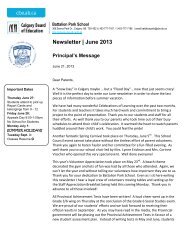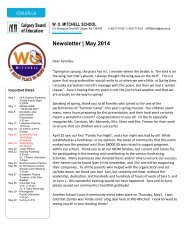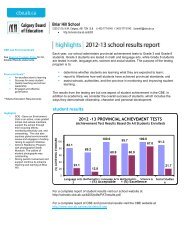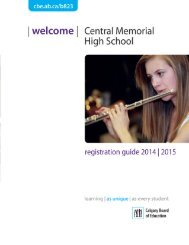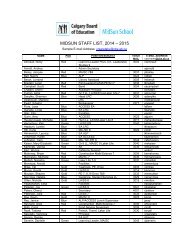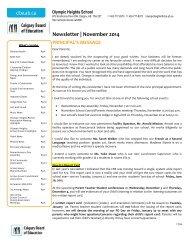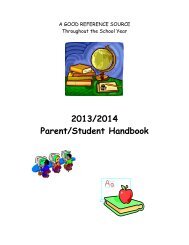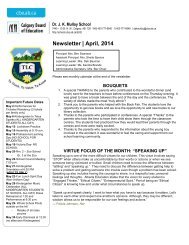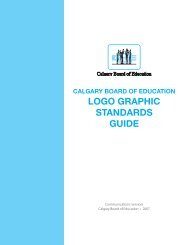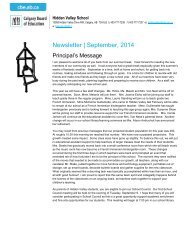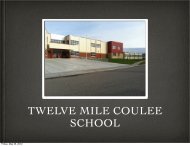Head Lice: Facts and Treatment - Calgary Board of Education
Head Lice: Facts and Treatment - Calgary Board of Education
Head Lice: Facts and Treatment - Calgary Board of Education
You also want an ePaper? Increase the reach of your titles
YUMPU automatically turns print PDFs into web optimized ePapers that Google loves.
How do I control lice at home<br />
• Bedding, towels, clothing, hats, toys, etc.,<br />
should be washed in hot water <strong>and</strong> dried<br />
in a hot dry cycle, dry cleaned, or sealed<br />
in plastic bags for two weeks. Do not use<br />
insect sprays because they can be<br />
harmful.<br />
• Soak combs, hairbrushes <strong>and</strong> hair<br />
ornaments in hot water for 1 hour.<br />
• Vacuum carpets, furniture <strong>and</strong> mattresses<br />
where the person with lice lays or sits.<br />
Never use insect sprays to control lice. They<br />
are unnecessary <strong>and</strong> harmful to people <strong>and</strong><br />
pets.<br />
How do I limit the spread <strong>of</strong> head lice<br />
Parents <strong>and</strong> schools both play a role in<br />
limiting head lice in schools, community<br />
groups <strong>and</strong> families.<br />
What role do parents <strong>and</strong> guardians play<br />
• Examine your child’s scalp every week.<br />
• Encourage children to avoid sharing<br />
combs, barrettes, hats, scarves,<br />
headphones or headgear.<br />
• Treat your child as quickly as possible.<br />
• Take the time to remove the nits after<br />
treatment.<br />
• Inform all possible contacts so other cases<br />
can be found <strong>and</strong> treated (e.g., teachers,<br />
parents <strong>of</strong> classmates, <strong>and</strong> playmates)<br />
• Once treated, it is not necessary to keep a<br />
child with head lice home from school.<br />
What role do the schools play<br />
• Provide information to parents about the<br />
detection <strong>and</strong> treatment <strong>of</strong> head lice.<br />
• <strong>Treatment</strong> information, prevention,<br />
consultation <strong>and</strong> control are available<br />
from public health nurses in schools.<br />
• School boards work closely with the<br />
<strong>Calgary</strong> Health Region to find ways <strong>of</strong><br />
limiting the spread <strong>of</strong> head lice.<br />
Parents are encouraged to call their school<br />
nurse, community health centre, or their<br />
family doctor for more information about<br />
prevention, recognition <strong>and</strong> treatment <strong>of</strong> head<br />
lice in their family.<br />
Call <strong>Calgary</strong> Health Link at<br />
943-LINK (5465) in the <strong>Calgary</strong> area or<br />
1-866-408-LINK (5465) toll-free for more<br />
information if you are pregnant,<br />
breastfeeding, have children less than 24<br />
months, or are allergic to ragweed or<br />
chrysanthemums.<br />
On-line resources:<br />
1. Canadian Pediatric Society<br />
www.caringforkids.cps.ca/whensick/<br />
<strong>Head</strong><strong>Lice</strong>.htm<br />
2. Centers for Disease Control <strong>and</strong><br />
Prevention<br />
www.cdc.gov/ncidod/dpd/parasites/lice/<br />
default.htm<br />
health information<br />
<strong>Head</strong> <strong>Lice</strong>:<br />
<strong>Facts</strong> <strong>and</strong><br />
<strong>Treatment</strong>
<strong>Head</strong> lice have been around for centuries.<br />
They continue to be a pest despite modern<br />
treatment <strong>and</strong> prevention programs. They do<br />
not spread any diseases, but are a concern to<br />
parents <strong>and</strong> their children.<br />
<strong>Facts</strong> about head lice<br />
• <strong>Head</strong> lice are small greyish insects the<br />
size <strong>of</strong> a grain <strong>of</strong> salt (1– 2 mm).<br />
• They do not jump or fly, but they move<br />
quickly.<br />
• An adult louse can live for 1 to 2 days<br />
away from the human head.<br />
• Nits (the eggs <strong>of</strong> lice) hatch in 7 to 9 days,<br />
Once hatched, lice need 7 to 13 days to<br />
mature <strong>and</strong> start producing nits.<br />
• A female louse will live about 25 days<br />
<strong>and</strong> can lay 4 to 10 eggs per day.<br />
• <strong>Head</strong> lice on humans are not the same as<br />
those found on house pets.<br />
• At any one time, 10% <strong>of</strong> elementary<br />
school children can have head lice.<br />
• Anyone can get head lice—there is no<br />
connection between head lice <strong>and</strong> how<br />
clean you are or your social status.<br />
• Constant itching <strong>of</strong> the scalp is <strong>of</strong>ten a<br />
sign <strong>of</strong> lice.<br />
How do you get head lice<br />
• Direct head-to-head contact is the most<br />
common way: A person’s head infested<br />
with lice must touch another person’s<br />
head.<br />
• Uncommon ways <strong>of</strong> spreading head lice<br />
are sharing hairbrushes, combs, hats,<br />
headgear, scarves <strong>and</strong> coats, or contact<br />
with pillowcases, blankets, <strong>and</strong> stuffed<br />
toys <strong>of</strong> people with head lice.<br />
• <strong>Head</strong> lice transmission can occur anytime<br />
children are in groups such as daycare,<br />
playgrounds, summer camps, schools <strong>and</strong><br />
families where one person has lice.<br />
Checking for head lice<br />
If you think your child has head lice, check<br />
them right away:<br />
• Look very carefully, lice are small.<br />
• The nits (about 1 mm long) can be seen<br />
firmly attached to hair (do not confuse<br />
with d<strong>and</strong>ruff, which is easily brushed<br />
<strong>of</strong>f).<br />
• <strong>Lice</strong> are usually found around the temple,<br />
above <strong>and</strong> behind the ears <strong>and</strong> at the back<br />
<strong>of</strong> the neck.<br />
• Have good lighting when you do a head<br />
check.<br />
How do you treat head lice<br />
If one person has head lice, all family<br />
members should be carefully examined for<br />
lice as well. Treat only those family members<br />
found to have lice.<br />
Treat head lice with anti-lice shampoo or<br />
lotions. Common treatment products are<br />
Nix ® , R & C, Kwellada-P ® , Pronto ® , <strong>and</strong><br />
Resultz ® .<br />
Each head lice treatment product is used<br />
differently. Read <strong>and</strong> follow product<br />
instructions <strong>and</strong> warnings very carefully. The<br />
following guidelines will assist you in<br />
treating the scalp for head lice.<br />
• Hair must be free <strong>of</strong> any hair products<br />
before treatment—they can decrease how<br />
well the anti-lice product works. Wash<br />
hair with plain shampoo. No creme rinse<br />
or 2 in 1 shampoo <strong>and</strong> conditioners. Rinse<br />
with water <strong>and</strong> dry well.<br />
• Use enough <strong>of</strong> the head lice product soak<br />
the hair completely (long hair may need<br />
more than one bottle). Leave the product<br />
on the hair for the recommended time—<br />
no longer.<br />
• After rinsing the lice product from the<br />
scalp, do not shampoo for at least two<br />
days after treatment. Shampooing too<br />
early can decrease how well the product<br />
works.<br />
After using a head lice product:<br />
• Remove remaining nits. Use a fine-tooth<br />
comb or your fingernails. Be patient—<br />
remember, the nits are very small. Put the<br />
nits in a bag <strong>and</strong> throw it out. It may take<br />
several days to remove all the nits.<br />
• If you see live lice 2 days after the first<br />
treatment, treat again with a different<br />
product. Follow with another treatment in<br />
7 to 10 days.<br />
• If no lice are seen re-treat with the same<br />
product 7 to 10 days after the first<br />
treatment. The second treatment kills nits<br />
that may have been missed the first time.<br />
• A number <strong>of</strong> alternative products (e.g., tea<br />
tree oil, petroleum jelly (e.g., Vaseline ® ),<br />
olive oil, <strong>and</strong> kerosene) have been<br />
suggested as treatment for head lice;<br />
however, there are no published trials on<br />
how safe or effective these home<br />
remedies are.



